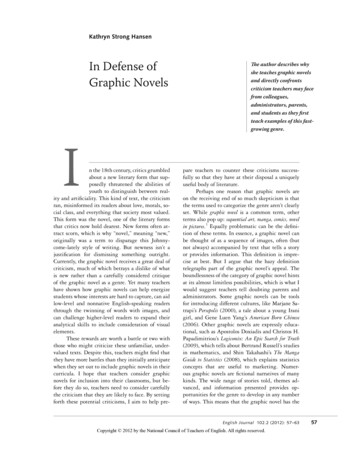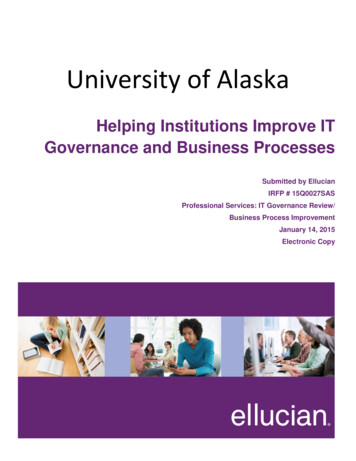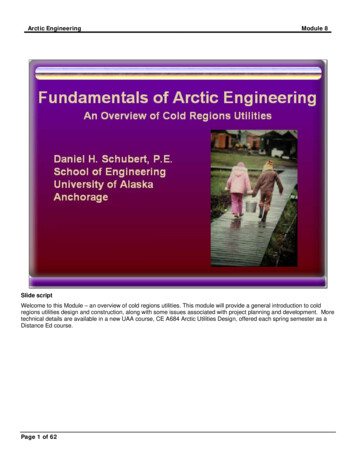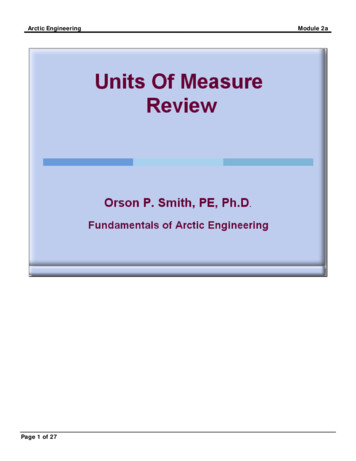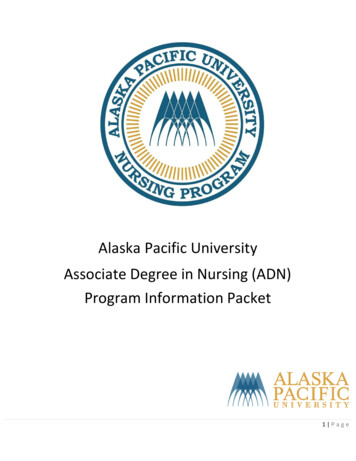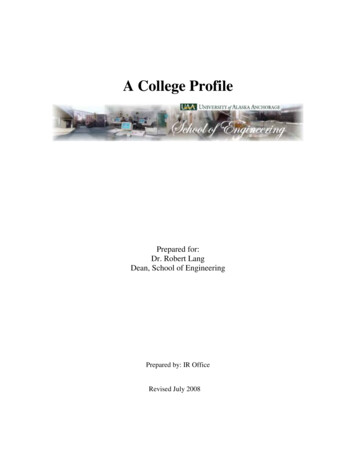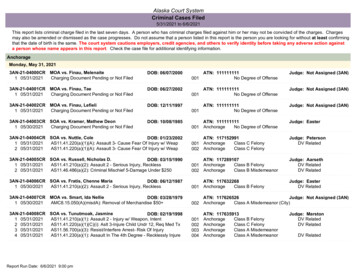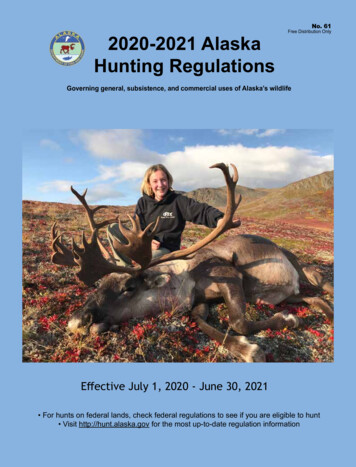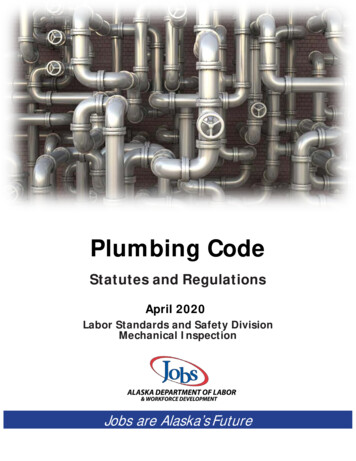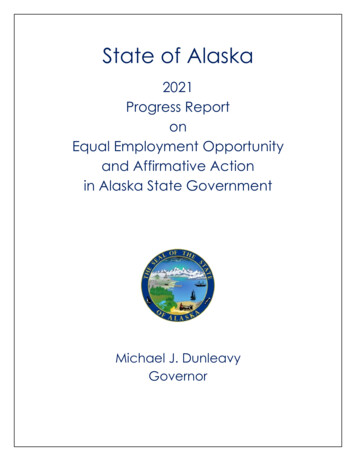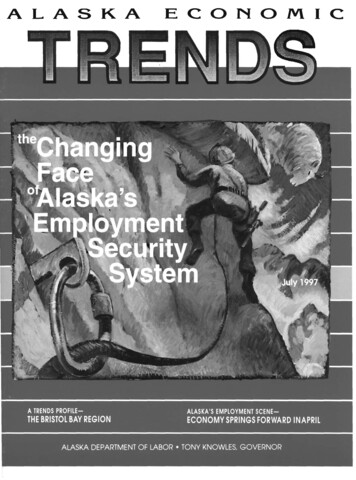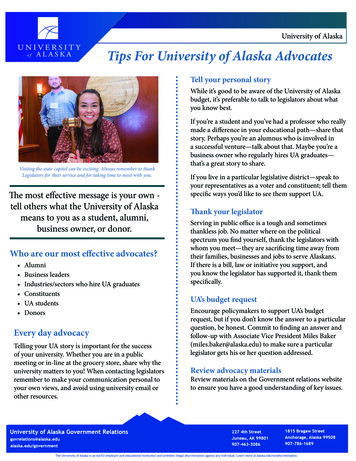
Transcription
University of AlaskaTips For University of Alaska AdvocatesTell your personal storyWhile it’s good to be aware of the University of Alaskabudget, it’s preferable to talk to legislators about whatyou know best.Visiting the state capitol can be exciting. Always remember to thankLegislators for their service and for taking time to meet with you.The most effective message is your own tell others what the University of Alaskameans to you as a student, alumni,business owner, or donor.Who are our most effective advocates? AlumniBusiness leadersIndustries/sectors who hire UA graduatesConstituentsUA studentsDonorsEvery day advocacyTelling your UA story is important for the successof your university. Whether you are in a publicmeeting or in-line at the grocery store, share why theuniversity matters to you! When contacting legislatorsremember to make your communication personal toyour own views, and avoid using university email orother resources.If you’re a student and you’ve had a professor who reallymade a difference in your educational path—share thatstory. Perhaps you’re an alumnus who is involved ina successful venture—talk about that. Maybe you’re abusiness owner who regularly hires UA graduates—that’s a great story to share.If you live in a particular legislative district—speak toyour representatives as a voter and constituent; tell themspecific ways you’d like to see them support UA.Thank your legislatorServing in public office is a tough and sometimesthankless job. No matter where on the politicalspectrum you find yourself, thank the legislators withwhom you meet—they are sacrificing time away fromtheir families, businesses and jobs to serve Alaskans.If there is a bill, law or initiative you support, andyou know the legislator has supported it, thank themspecifically.UA’s budget requestEncourage policymakers to support UA’s budgetrequest, but if you don’t know the answer to a particularquestion, be honest. Commit to finding an answer andfollow-up with Associate Vice President Miles Baker(miles.baker@alaska.edu) to make sure a particularlegislator gets his or her question addressed.Review advocacy materialsReview materials on the Government relations websiteto ensure you have a good understanding of key issues.
University of Alaska FY20 Operating BudgetKey Talking Points - Governor’s Budget Proposal Behind every thriving economy is a stronguniversity system. Education fuels opportunity,growth and economic prosperity. Education is a core responsibility of the state.UA is established in the Alaska Constitution. UA provides 90 percent of all higher educationin Alaska and is the state’s largest workforcedevelopment organization. Given thecondition of Alaska’s economy and the need forinnovation and diversification, this is preciselythe wrong time to divest in education. UA is a prime mover in Alaska’s economygenerating 1.1 billion in annual economicactivity, including the purchase of 123 millionin goods and services from 2,000 Alaskanbusinesses. The Governor’s proposal is a 41 percent ( 134million) reduction in state funding to theUniversity of Alaska. If sustained, this would be the largest year-overyear budget reduction in the university’s 100year history. UA has managed budget reductions in four outof the last five years, a cumulative loss of over 195 million, severely impacting our ability toperform our mission on behalf of Alaska. The state’s public investment in UA is essentialto our ability to raise the other 63 percent ofour budget – from student tuition, service fees,research revenue, alumni, private and otherphilanthropic giving.If this passes, it would be the largestbudget cut in the university’s 100year history. Tuition and research revenue – two criticalsources of funding – will drop as a result oflower enrollment and fewer academic programs. A cut of this magnitude, will necessitate deepcuts that will impact every campus, programand aspect of our mission – education, research,community service. UA leads the world in Arctic research and builtan international reputation that attracts faculty,students and investment. However, we operatein a highly mobile, international market for bothtalent and resources. Talent follows capital. There are 1,200 fewer people working at UAthan there were just four years ago. This budgetwill likely result in the loss of an additional 1,300staff and faculty. Alaska has the lowest college going rate in thenation. UA provides access and opportunityto every Alaskan through our network ofcommunity campuses.
Fall 2018 Fast Facts and FiguresUniversity of Alaska At a GlanceMISSION: The University of Alaska inspires learning,and advances and disseminates knowledge throughteaching, research and public service, emphasizing theNorth and its diverse peoples.University of Alaska HistoryFounded in 1917 as the Alaska Agricultural College and Schoolof Mines; renamed University of Alaska in 1935. Today we arethree universities, 13 community campuses and outreach centersthroughout Alaska.Academic ProfileStudents from Alaska - 88%Median Age - 25Student Faculty Ratio - 11:1Faculty - 1,232Staff - 2,532UA Scholars - 1,817Alaska Performance Scholarship - 2,709Dual-Enrollment Students - 2,992UA Alumni - more than 100,000Degrees and ProgramsDegrees and Programs Offered - 588Bachelor’s 6-yr. Graduation Rate - 36%Degrees & Certificates Granted - 4,554Licensures & Endorsements - 614Certificates - 295Associate - 1,151Bachelor’s - 1,876Master’s - 561Doctorate - 57Budget & FinancesUA Operating Budget - 820 millionState Funding - 317 millionTuition & Fees - 135 millionEnrollmentTotal Student Headcount - 26,641External Research Funding - 141 millionLands & FacilitiesUniversity of Alaska Anchorage - 16,530Total UA Lands - 150,446 acresUniversity of Alaska Fairbanks - 8,336Land Grant owed - more than 360,000 acresUniversity of Alaska Southeast - 2,561Facilities - 424Total Full-Time Equivalency* - 17,555*One student FTE is calculated as 30 student credit hoursfor courses below the 500 level and 24 student credit hoursfor courses at the 500 level and above.Average facilities age - 33 yearsFigures from UA Data Strategy and Institutional Research,March 2019; UA Land Management, FY18
University of Alaska FY20 Operating BudgetThe University of Alaska needs your supportMajor driver of economic activityThe university drives Alaska’s economy. In addition totraining and educating the workforce, UA generates 1.1 billion economic activity annually, including direct,in-state expenditures by the university, students andvisitors, and additional indirect spending. That’s allmoney circulating in our state as a direct benefit of theUniversity of Alaska.Workforce development is a critical part of the educational mission of theuniversity. From community campuses to graduate schools, UA driveseconomic growth and innovation.The governor’s 134 million cut isthe single largest reduction in theuniversity’s 100-year historySpending on goods and services 36,000,000 39,000,000 34,000,000 14,000,000AnchorageFairbanksJuneauOtherThe University of Alaska purchased 122.6 million from more than 2,000 Alaskabusinesses and organizations in 2015. Source: McDowell, 2015UA is directly tied to Alaska’s economyEmployment and payrollIt takes a great university to build a great state. As aconstitutionally established public higher educationsystem, UA has a responsibility to meet the state’shigher education and workforce development needs.UA is one of the largest employers in Alaska. In 2015,UA paid 346 million in annual wages and supported anaverage of 7,548 jobs. When jobs indirectly linked to theuniversity were also considered, UA supported 15,740 jobstotaling 630 million in annual wages. Those good wagesare disappearing along with the benefits of an employedpopulation.Cutting state support to this extent sends a negativemessage to students and all Alaskans.The governor’s plan assumes UA could double tuitionand fee revenue from the current year. In the face ofdeclining enrollments, and year-over-year increasesto tuition, the ability to capture 154 million in newtuition and fees is not realistic.We have only a few months to prepare viable optionsfor Alaska’s future. UA has chosen to lead, and that isexactly what we will continue to do.ImpactDirectIndirect& InducedTotalEmployment Impact (jobs)8,3407,40015,740Payroll Impact ( million) 346 284 630Impacts extend across AlaskaSource: McDowell, 2015As a result of four out of five years of budget cuts, 1,300fewer people work at UA than five years ago. This hasresulted in reduced spending on goods and services, anda negative impact on Alaska far greater than the budgetcuts alone.
University of Alaska FY20 Operating BudgetUniversity of Alaska mission criticalUniversity of Alaska magnitude of impactDevastating reductionThe proposed 41 percent reduction in state UGF fundingwould hurt students, the university system and severelyimpact the communities it serves.To put this 134 million cut in perspective, consider: UAA receives 120 million in UGF; UAF receives 164 million UGF; UAS receives 25 million UGF; UA Statewide receives 18 million UGF; all community campuses combined receive 38million UGF.Reductions in state funding impact studentsUA is commited to overcoming Alaska’schallengesThrough education, research and public service, UA iscommitted to: Bring down health care costs (#1 in nation) Stimulate economic development (#42 in US in NewEconomy Index) Prepare Alaskans for jobs (#1 in unemployment) Contribute to Alaska’s job growth (#50 in US) Build a culture of education (#50 in postsecondaryparticipation in US) Prepare teachers (67 percent hired from Outside) Understand and mitigate impacts of climate change Bring down crime rate (#1 concern of Alaskans) Reduce energy costs (#6 in US)The bottom lineAlaska’s economy is in recession. The University ofAlaska is one of the most valuable tools for advancingand improving Alaska’s future.Given our economy, this is precisely the wrong timeto cut education. Alaska’s economy needs a strongeducation system.State funding support has been trending downwardfor more than a decade. In turn, increased pressure istransferred to students to bridge the gap. At the sametime there are fewer students. UA’s enrollment dropped each of the last seven years,from 34,983 in 2011 to 26,641 in 2018. This is largelyrelated to budget cuts and demographic changes. In the 2010-2011 academic year, tuition rates were 127- 170 per credit hour. By 2019-2020 theyincreased to 223- 269 per credit hour. We would have to double the rate yet again to makeup for this cut through tuition revenue alone, whichis not a realistic option.Looking forward, 65 percent of Alaska’s workforce is projected (by2025) to require some post-secondary education. Depending on thesource, Alaska is now somewhere between 37 or 50 percent.
University of Alaska Land GrantHonoring Alaska’s Land Grant PromiseThe University of Alaska (UA) is a land grantinstitution, having received lands Congress mandatedunder a 1929 law, but UA received only a portion ofthe lands Congress had reserved for it under an earlier1915 law which later were conveyed to the State forUA’s benefit in the Statehood Act.The Alaska Agricultural College and School of Mines was established asa Land Grant university on May 3, 1917. Although it was thought thatthe university would receive lands with statehood, UA never received itsfull allotment.UA is still due approximately 360,000acres of land grant entitlementAbout UA’s LandsUA has one of the smallest holdings of all U.S. landgrant institutions. Only Delaware (90,000 acres) andHawaii (no land, but with a large monetary grant in lieuof land) received less land, and even Rhode Island has alarger land grant than UA.Of UA’s current land holdings, about 12,000 acres aredesignated for education or research. Although theremainder are available for sale or development, mostare remote, inaccessible parcels, whose value may not berealized for years or decades to come.The Alaska Legislature in 2000 and 2005 attempted toremedy UA’s land grant gap with a large land conveyanceto UA, but this was judicially abrogated by a courtdecision in 2009. Since then, UA has been striving to getthe state and federal governments to take collaborativeaction to fulfill UA’s unkept land grant promise in a waythat will withstand judicial scrutiny.How UA has used its Grant LandsIncome from UA’s lands has funded the highlysuccessful UA Scholars Program, awarding 12,000scholarships to the top 10 percent of graduates fromeach Alaska high school who attend UA. To date,over 9,000 students have benefitted. Land earningshave also supported teaching and research innatural resources, fisheries/ocean science, biology,agriculture, minerals, and education.Since 1987, UA’s Land Management office hasgenerated 211 million, from real estate sales ( 159.5million), timber sales ( 46.5 million), material/mining ( 3.3 million), and oil and gas ( 1.6 million).But much more could have been generated had theland grant promise been fulfilled.While UA, like all public land grant universities, willnever be completely financially independent and willcontinue to need support from other sources, theability to generate revenues from a fully endowedland grant will better enable UA to withstand theunevenness of state general fund revenues over time.
for Alaska’s future. UA has chosen to lead, and that is exactly what we will continue to do. Employment and payroll UA is one of the largest employers in Alaska. In 2015, UA paid 346 million in annual wages and supported an average of 7,548 jobs. When jobs indirectly linked to the university were also considered, UA supported 15,740 jobs
